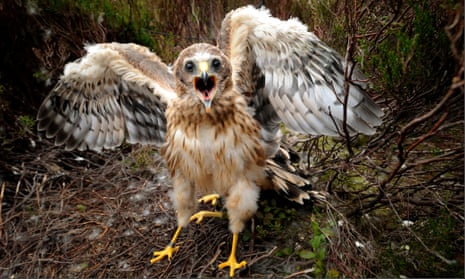The endangered hen harrier is continuing its recovery from near extinction in England with this summer set to have the highest number of chicks fledging since 2002.
Of 24 successful nests producing at least 77 fledged chicks this summer, 19 were on moors managed for red grouse, according to the Moorland Association.
The grouse shooting industry hailed the success as a vindication for controversial brood management, in which some chicks are removed from nests and reared in captivity if multiple nests are made on grouse moors.
Hen harriers like to nest in proximity to each other, but grouse moor managers complain that concentrations of the bird predate too many red grouse, which provide a lucrative driven grouse shooting season.
The brood management trial began in 2018 but was disavowed by conservation groups such as the RSPB, who argue that chicks should not be removed while the illegal persecution of hen harriers continues.
“This is another excellent year for hen harrier breeding,” said Amanda Anderson, the director of the Moorland Association. “Three good years in a row shows that we have the right strategy to help the population to recover to a sustainable level, occupying a much greater area of England.
“The management carried out on grouse moors by gamekeepers provides an ideal habitat for birds of prey, with fewer predators to steal their eggs, and good numbers of prey species such as small mammals and other birds.”
The figures have not yet been confirmed by Natural England, the government’s conservation watchdog, and some conservationists argue the Moorland Association is using a very wide definition of grouse moor to claim so many successful nests are on grouse shooting land.
“These are not official figures,” said Mark Avery of the campaign group Wild Justice. “They are from an incredibly vested interest which itself is responsible for the lack of hen harriers. They are trying to make a terrible situation look better than it is.
“There should be more than 300 pairs of hen harriers nesting in England and there aren’t. There is one solution to the hen harrier problem – stop killing hen harriers, like the law says.”
Four young harriers fledged from the RSPB’s Geltsdale reserve for the first time since 2016, but two male harriers disappeared there in the spring, with suspected illegal persecution being investigated by the police.
Jim Wardill, the RSPB operations director for the north of England, said: “We know how important the management of our uplands is for the recovery of these birds and hope that this signals that attitudes are changing towards issues such as persecution. Whether the land is managed for water supply, farming, forestry or shooting, we need everyone to work together to build on this success and restore England’s population to the known potential of 300 nests.”
Chris Packham and Megan McCubbin are hosting the eighth annual Hen Harrier Day on Saturday, celebrating the bird and efforts to save it, with artwork by Jim Moir – popularly known as the comedian Vic Reeves – being auctioned to raise money for hen harrier protection.
